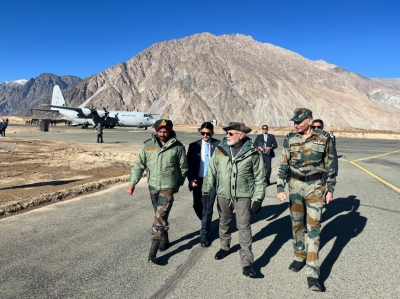A tale of two Kashmirs: 26 years after Kargil, a line of contrast across the LoC
By IANS | Updated: July 25, 2025 17:44 IST2025-07-25T17:39:35+5:302025-07-25T17:44:31+5:30
New Delhi, July 25 As India marks the 26th anniversary of Kargil Vijay Diwas, the story of Kashmir ...

A tale of two Kashmirs: 26 years after Kargil, a line of contrast across the LoC
New Delhi, July 25 As India marks the 26th anniversary of Kargil Vijay Diwas, the story of Kashmir is no longer just about territory and conflict.
It is about transformation — one that sets apart Jammu and Kashmir from Pakistan-occupied Jammu and Kashmir (PoJK) and Gilgit-Baltistan (PoGB) like never before.
In the summer of 1999, Indian forces evicted Pakistani intruders from the icy heights of Kargil. It was a resounding military victory, but two and a half decades later, the deeper triumph lies in development and dignity.
Today, the Jammu and Kashmir region stands transformed — with militancy at its lowest, youth empowered, and infrastructure booming — while PoJK and PoGB languish in repression, poverty, and neglect.
Since the abrogation of Article 370 in 2019, Jammu and Kashmir has seen unprecedented progress. Smart city projects in Srinagar, the all-weather Zojila Tunnel, an upgraded Kargil airport, IIT and NIT campuses, new railway lines and hospitals have redefined the region.
Notably, the literacy rate stands at over 67 per cent, with a significant rise in enrolment and female education. Over 1.8 million tourists visited in 2024, and global platforms like the G20 meet in Srinagar have rebranded the Valley as a hub of opportunity. Youth from Kupwara to Pulwama are becoming entrepreneurs, athletes, and innovators.
From Olympian Arif Khan to renewable energy champion Zahoor Ahmad, new icons are emerging. Education enrolment, especially among girls, is steadily rising.
On the other side of the Line of Control, PoJK and PoGB remain trapped in infrastructure decay, blackout-ridden towns, and economic marginalisation.
The China-Pakistan-Economic-Corridor (CPEC) projects, hailed as game-changers, have benefitted only the military elite.
Clean water, jobs, healthcare — all remain scarce. Even state employees protested in July 2025 over unpaid wages, only to be threatened into silence.
Civil liberties are non-existent at the other side of LoC. Dissent is crushed under constitutional gag orders, local languages are vanishing with languages like Balti and Shina being pushed aside in favour of Urdu and youth are lured into radicalisation in the absence of education and employment.
The LoC today does not just divide land — it separates two models of governance.
One that builds futures; the other that buries them under geopolitics. Kargil was India’s military win in 1999. In 2025, it’s a moral and developmental one — visible in the soaring aspirations of its people, and the stark silence across the border.
Disclaimer: This post has been auto-published from an agency feed without any modifications to the text and has not been reviewed by an editor
Open in app